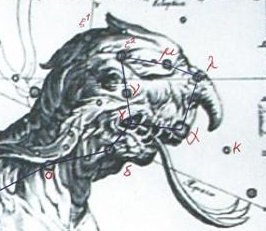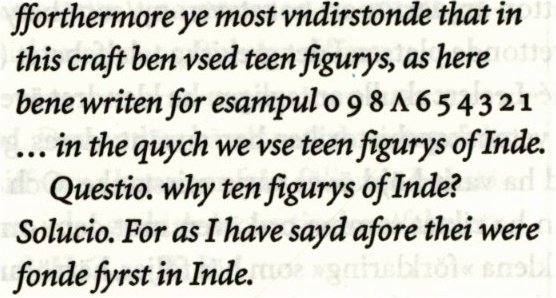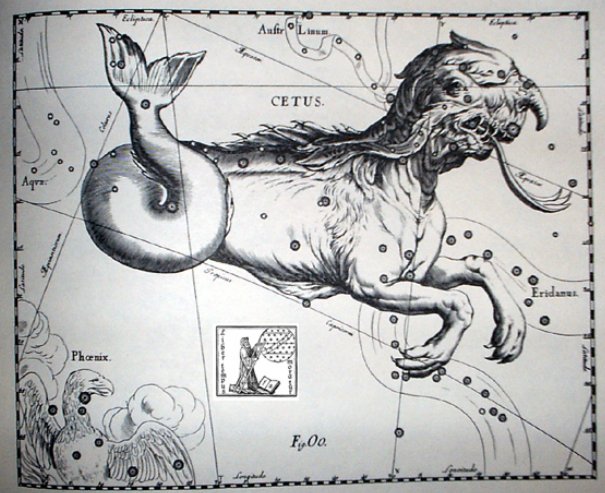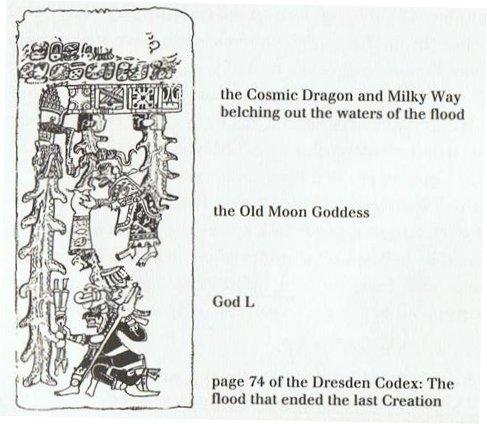418. The C text seems to document the view on Easter Island whereas the G text - which was given to the foreign officers onboard O'Higgins - naturally ought to describe the situation in the north (from where they originated): ... The officers of the Chilean corvette O'Higgins received this tablet and the Large Santiago Tablet from Father Roussel on Rapa Nui in 1870. These two tablets have since been kept in Santiago, Chile, which explains their names ...
When in early November (May + 6 months) on Easter Island Menkar - the Nose of the Sea Beast (α Ceti) - was observed close to the Full Moon they knew summer was a-head.
The G text, on the other hand, had the right ascension line down from Dramasa - the South Pole star, α Octantis - at the Full Moon in early August (February + 6 months) as a sign of the beginning of a new year. Hun-Nal-Ye 'became the sky' in 5 February (36) and this in a way was 36 + 182 = 218 (6 August) = half a year - 1 week before 13 August (225) when our present world was created:
The creation of our present world was in day 225 and 225 + 183 = 408 = 366 + 42, i.e. the night which at the time of rongorongo had the Full Moon at February 11 (42). Remarkably the Full Moon was here at Bunda (the Foundation, ξ Aquarii, *327) or 2 days before the Tail of the Goat (Deneb Algiedi, δ Capricorni, *329), as if alluding to 3114 BC.
From February 9 (40) to May 4 (124) - at Menkar - there were 84 days, and Sadalsud (*325 → Julian equinox, day 84 = 124 - 40) was the day each year when the Chorti diviners began searching for their 5 foundation stones: ... On February 9 the Chorti Ah K'in, 'diviners', begin the agricultural year. Both the 260-day cycle and the solar year are used in setting dates for religious and agricultural ceremonies, especially when those rituals fall at the same time in both calendars. The ceremony begins when the diviners go to a sacred spring where they choose five stones with the proper shape and color. These stones will mark the five positions of the sacred cosmogram created by the ritual. When the stones are brought back to the ceremonial house, two diviners start the ritual by placing the stones on a table in a careful pattern that reproduces the schematic of the universe. At the same time, helpers under the table replace last year's diagram with the new one. They believe that by placing the cosmic diagram under the base of God at the center of the world they demonstrate that God dominates the universe. The priests place the stones in a very particular order. First the stone that corresponds to the sun in the eastern, sunrise position of summer solstice is set down; then the stone corresponding to the western, sunset position of the same solstice. This is followed by stones representing the western, sunset position of the winter solstice, then its eastern, sunrise position. Together these four stones form a square. They sit at the four corners of the square just as we saw in the Creation story from the Classic period and in the Popol Vuh. Finally, the center stone is placed to form the ancient five-point sign modern researchers called the quincunx ...
The G text began with Rogo in Gb6-26 at heliacal Sirrah
and from there to heliacal Sadalsud in Gb2-6 there were 63 + 1 + 229 + 32 = 325 days.
"... β [Sadalsud] alone marked the sieu Heu, Hiu, or Hū, Void, anciently Ko, the central one of the seven sieu which, taken together, were known as Heung Wu, the Black Warrior, in the northern quarter of the sky ..." (Allen) The C text was beginning with the Full Moon at Sirrah
in day number (80 + 183 = 263 = September 20) and from there to Bharani at the Full Moon in Cb1-15 there were 392 + 15 = 407 = 366 + 41 days.
325.9 - 41.4 = 284.5 = 364 - 79.5. 8 nights after Cb1-10 the Full Moon was at the Nose of the Sea-beast (Menkar, α Ceti) and 5 days before Sadalsud at Gb2-6 the Sun was at the right ascension line coming down from Dramasa (σ Octantis):
Aquarius was around 80 days earlier than Cetus one could say. However, a better description should be to state that from the Sea-beast crawling up onto terra firma at the bend in the Eridanus river to the water gushing out from the Urn of Aquarius there were around 285 days. Right ascension day *285 corresponded to December 31 (80 + 285 = 365) and time began at 0h. The king lists began with Adam (→ Land) and ended with Noah (→ Deluge).
|
||||||||||||||||||||||||||||||||||||||||||||||||||||||||||||||||||||||||||||||||||||||||||||||||||||||||||||||||||||||||||||||||||||||||||||||||||||||||||||||||||||||||||||||||||||||||||||||||||||||||||||||||||||||||||||||||||||||||||||||||||||||||||||||||||||||||||||||||||||||||||||||||||||||||||||||||||
.jpg)
















